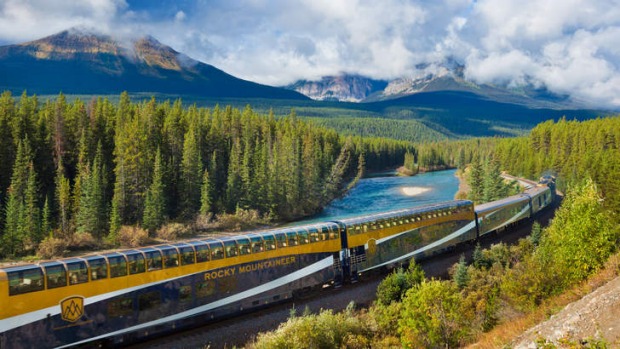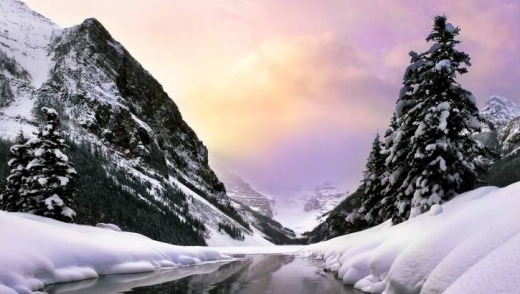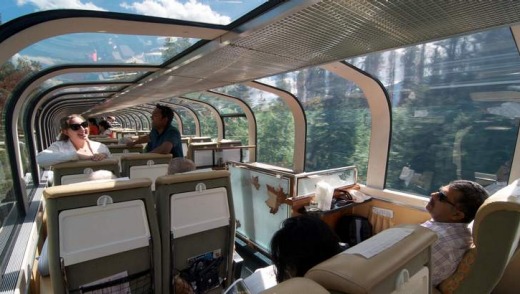
Setting her watch to mountain time and keeping an eye out for bears, Elspeth Callender boards Canada's famed Rocky Mountaineer train.
For more than two decades, Lake Louise station has seen every passenger train on that line roll on through with the whistle blowing and no intention of coming to a halt. Now, the Rocky Mountaineer makes regularly scheduled stops at this historic landmark as part of its First Passage to the West route between Vancouver and Calgary, which retraces the original path of the Canadian Pacific Railway.
Along with settlement and development of Canada's west, access to the natural wonders of the Rocky Mountains was a large part of why the railroad was first constructed across this mountain range. As far back as the late 1800s, visionaries such as Canadian Pacific Railway's general manager, William Cornelius Van Horne, saw rail travel as a way for ordinary people – not just the mountaineers and adventurers – to visit extraordinary places.

Lake Louise is one such place.
Several glaciers overlook this natural waterhole. The so-called rock flour carried into the lake by melted ice causes the lake to appear turquoise.
When the Stoney Nakota First Nations people led horse wrangler and packer Tom Wilson to the glacial shores of the Lake of the Little Fishes in 1882, he was more bedazzled by the colour of the lake than its contents and called it Emerald Lake. But the name soon changed again when Queen Victoria's fourth daughter was owed some compensation for marrying the governor-general of Canada and being forced to move to an even colder climate than England.

The hamlet of Lake Louise, which today includes a very small downtown area and a great big ski resort, has also been through a string of names. It was originally the Summit, then Holt City, Laggan and finally Lake Louise.
By 1886, the station was internationally famous after the Prime Minister of Canada, John Macdonald, and his wife travelled across Canada on the newly completed railway line. After an engine switch at Laggan, Lady Macdonald insisted upon riding through the Rockies on the engine's cowcatcher, the metal grill projecting from the front of a locomotive for clearing obstructions from the track.
The original station building was constructed from peeled logs. In 1910, another station of a similar style was built and the original became a baggage shed and was eventually dismantled in the 1970s and reconstructed in Heritage Park, Calgary, where it still stands. From 1910 the "new" station served passengers for more than 80 years before being closed in 1990. Even a tramway was built in 1912 and for a couple of decades transported visitors a few kilometres up the hill to Lake Louise, sometimes making as many as 30 round trips a day.
I'm a little disappointed that there's absolutely no chance of travelling on the cowcatcher but I am still excited by the prospect of a two-day Rocky Mountaineer trip from Vancouver to Lake Louise. We depart from the railway station in Vancouver after some lucky kid gets to toot-toooot an old-fashioned train whistle and ticketholders follow a bagpiper onto the station in search of respective carriages.
Seated around me are a family from Dallas, Texas, with the children's grandma visiting from New Delhi; a young couple from Australia on their honeymoon; a suited, moustached Englishman and a couple of New Yorkers with Long Island accents.
We're not so unlike those who made the same journey on the same route a century earlier, when tourists were already flocking to the Rockies. The Trans-Canada Highway didn't officially open until 1962. Until then, just about everyone heading to Lake Louise went by train.
Gold Leaf, the class in which I'm travelling, is a particularly sociable set-up because, unlike Silver and Red Leaf, meals are served in a separate dining car. The outdoor vestibule is also conducive to mingling and, over the two days, I meet most of the people in my carriage. A friendly vibe develops, helped by the commentary, song-of-the-day, poetry competition and the increasingly dramatic Rocky Mountain scenery.
"Mum, this is fun, so much fun," the six-year-old girl in front of me declares only halfway through day one. Her older brother has had his nose attached to the glass for the last hour.
As we roll through the countryside people wave at the train with enthusiasm – from letterboxes, backyards and even people waiting in their vehicles at crossings wave as we pass.
On the second day, at lower speeds, we're almost sneaking through the forest with very little cleared space needed on either side of the track. It's why many a bear has been seen on this route over the years.
The tune Canadian Pacific plays as we head up into the Selkirk Mountains. The surveyor who found this route had Rogers Pass named after him. The immigrants who then laid the tracks earned between 75c and $2.50 a day.
In the late afternoon light, as the towering peaks turn orange, we reach the boundary of Banff National Park. We make our way through the Spiral Tunnels, pass into Alberta, cross the Continental Divide, change our watches to mountain time and pull into Lake Louise station before dark.
Back when life here revolved around the station, passengers would have arrived to find a stationmaster's house, a police station, a store and a small hotel called the Mountain Inn that doubled as the post office. Today, just the station building remains and some charming old Canadian Pacific railcars that once belonged to people with names such as Lord Shaughnessy and Buck Crump.
There's a bus waiting to take us up the hill. As so many ordinary people from all over the world have done for generations, I have arrived at Lake Louise by train to stay at the historic Chateau, marvel at the lake's natural beauty and explore Canada's oldest national park.
The writer was a guest of Rocky Mountaineer.
ABOUT THE WRITER
Elspeth Callender isn't quite sure if she's a traveller who writes or a writer who travels, but is really enjoying trying to work it out.
FIVE MORE THINGS TO DO
DINE ON THE LINE
Wine and dine at Lake Louise Railway Station and Restaurant in either the repurposed station building or in one of the century-old onsite railway cars. See lakelouisestation.com.
BEAR DETAILS
Ride high on the open-air chairs of Lake Louise Gondola for a 14-minute elevated trip through the Rockies with excellent grizzly bear-viewing opportunities. See lakelouisegondola.com.
PADDLE POWER
Hire a canoe from Lake Louise Boathouse and paddle the emerald waters of this iconic glacial lake with views of Banff National Park and Lake Louise Chateau. See fairmont.com/lake-louise.
RIDING HIGH
Saddle up and enjoy a horseback ride, led by experienced operators, through the sub-alpine forests of Banff National Park to the historic Lake Agnes teahouse situated high above Lake Louise. See brewsteradventures.com.
SPRUCED UP
Stroll the walking tracks through the forest of spruce and fir surrounding the magnificent Lake Louise. Have a picnic lunch at Chateau Deli.
TRIP NOTES
GETTING THERE
Qantas flies daily to Vancouver from Sydney, phone 13 13 13 or see qantas.com.au.
STAYING THERE
The Fairmont Hotel, Vancouver, 900 West Georgia Street, Vancouver; +1 604 662 1944; fairmont.com. Rooms start at around $CAN299. The Fairmont Chateau Lake Louise (see over).
SEE + DO
Classic First Passage to the West Vacation runs every three days to once a week over the 2014 season phone 0011 800 0606 7372; rockymountaineer.com; from $1331 each.
MORE INFORMATION
canada.travel